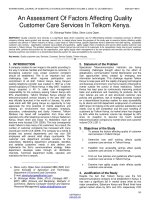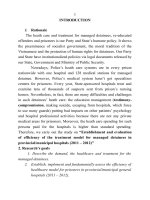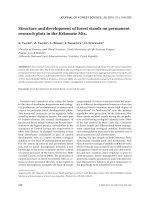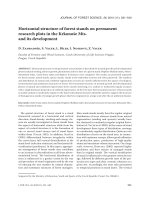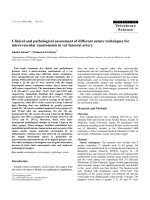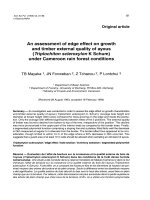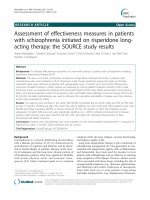ASSESSMENT OF HIV, AFB (+) TB CONTRACTION AND EFFICACY OF INTERVENTION MEASURES ON INTRAVENOUS DRUG USERS IN DAKLAK PROVINCE, 2011 2012
Bạn đang xem bản rút gọn của tài liệu. Xem và tải ngay bản đầy đủ của tài liệu tại đây (554.96 KB, 24 trang )
1
MINISTRY OF TRAINING AND EDUCATION
MINISTRY OF HEALTH
NATIONAL INSTITUTE OF HYGIENE AND
EPIDEMIOLOGY
- - - - - - - - - * - - - - - - - - -
PHAM THO DUOC
ASSESSMENT OF HIV, AFB (+) TB
CONTRACTION AND EFFICACY OF
INTERVENTION MEASURES ON
INTRAVENOUS DRUG USERS IN DAKLAK
PROVINCE, 2011 - 2012
Major : Public Health
Serial No. : 62 72 03 01
SUMMARY OF DOCTORAL THESIS ON PUBLIC
HEALTH
HA NOI – 2014
2
THE ISSUE IN QUESTION
1. The imperative of thesis
HIV/AIDS and TB are and were two troubling public
health issues. With two agents, two transmission mechanisms,
exposed subjects pose different infected symptoms; however,
the conditions of the two health issues go hand in hand. HIV
was the main cause of failure in the preventive strategy of TB
and vice versa, TB was the main cause of fatalities among HIV
infected persons. Scientific evidence had revealed that
intravenous drug users (IDUs) had higher risk of HIV
infection, implicating opportunistic infections among which
was TB. The increase of TB infections might create a boost on
increase of HIV/TB coinfection.
There had been tremendous researches on the prevalence
of HIV infections among IDUs and TB infected group in
several areas in the nation. However, in Vietnam, and
particularly Daklak Province, there had not been many specific
study on HIV infections, AFB (+) TB and HIV/TB coinfection
among IDUs, in order to obtain scientific evidence which shall
in turn be helpful for planning preventive strategy on IDUs in
particular and the community health in general. On that basis,
we conducted this study with the following goals:
1. Determining the prevalence of HIV and AFB (+) infections
among IDUs in Daklak Province, 2011.
2. Providing descriptions of several related factors of HIV/TB
coinfections on study subjects.
3. Determining the efficacy of community intervention
measures to prevent HIV and TB infections among IDUs
during the period 2011 – 2012.
3
2. Further contributions by thesis
This thesis was the first systematic study on the
prevalence of HIV, AFB (+) TB and HIV/TB coinfection
among IDUs in Daklak. This study provided descriptions on
several risk factors which might increase HIV/TB coinfection.
The preliminary study roll-out had accurately assessed the
efficacy of community intervention measures against HIV, TB
infections among IDUs in Daklak Province.
3. Scientific significance and practicality of thesis
3.1. Scientific significance:
Thesis adopted the cross-sectional study model of pre-
and post- community intervention. Adopted methods on
sample collection and data analysis were accurate and
creditable. From the collected data and result interpretations,
the thesis had determined certain indices of prevalence of HIV,
AFB (+) TB, HIV/TB coinfection, HIV/TB coinfection risk
factor index and efficacy index of community intervention
measures among IDUs on study areas in Daklak Province.
3.2. Practicality of thesis:
The study results provided preliminary scientific data
which contribute to proposal of intervention measures model,
and control of HIV, AFB (+) TB and HIV/TB coinfection
among IDUs.
The study results provided practical data serving teaching
purposes and being the prerequisite for further follow-up
studies.
4. Outline of thesis: the body of thesis consisted of 126 pages
(excluding appendices, table of contents, glossary) and was
divided into: Issues in question (3 pages); Chapter 1 – General
(43 pages); Chapter 2 – study subjects and approach (17
4
pages); Chapter 3 – study results (28 pages); Chapter 4 –
Discussion (31 pages); Conclusion (2 pages);
Recommendation (1 page) and Portfolio of publicized research
papers (1 page). Thesis had 45 tables, 07 graphs, 04 maps and
01 figure. The appendices consisted of 120 references (37 in
Vietnamese, 83 in English), surveys (commitment on study
participation and survey questions); blood collection slip; oral
fluid collection slip;
CHAPTER 1: GENERAL
1.1. The situation of HIV/TB coinfection
1.1.1. The situation of HIV/TB coinfection on a global scale
According to WHO, by the end of 2012, there were
approximately 34 million cases of HIV infections globally.
Among HIV infected persons, one third of them had high risk
of TB infection, therefore, increased the number of TB
infected persons. HIV infected persons had 20-30 times risk of
contracting active TB in compared with HIV non-infected
persons. An estimation of 1.4 million deaths were caused by
TB in 2011.
1.1.2. The situation of HIV/TB coinfection in Vietnam and
Daklak Province
The rate of HIV/TB coinfection had increased drastically,
from 0.5% in 1996 to 4.8% in 2004. A study took place in
2005 in 6 provinces had revealed the prevalence of HIV/TB
coinfection to be 4.7%. Investigation on mortality rate relating
to coinfection in HCMC had revealed that 34.1% TB/HIV
patients were deceased before the completion of treatment
regimens and the mortality rate among AFB (+) TB patients
5
infected with HIV was 26% in compared with 2% among HIV
(-) patients.
From the first 5 cases detected of HIV infections in 1993
until the end of December, 2010, Daklak Province had
recorded 1,520 cases of HIV infection among which 623 were
advanced to AIDS, 351 were deceased because of AIDS; the
rate of HIV infection among TB patients was 3.1%.
1.2. Factors relating to HIV/TB coinfection
1.2.1. Socio-economic and living condition factor
Factors such as: social integrity, degrading behaviors,
ethnic groups, financial problems, poverty, illiteracy,
unemployment, domestic violence or sexual discrimination,
etc. might affect the risk of HIV/TB coinfection in a
community, especially among high risk groups (Intravenous
drug users (IDUs), prostitutes, and MSM).
1.2.2. Knowledge and behavior
Lack of knowledge, negative behaviors and action against
the norm such as drug abusing which might lead to sharing of
needles and unsafe sexual intercourse are among factors that
affected the increase of HIV infections. HIV infections shall
weaken the immune system which implicated opportunistic
infections, among which was TB.
2.2.2. Group of intravenous drug users
Intravenous drug users were the group of highest risk of
HIV infection due to sharing of needles and unsafe sexual
intercourse.
2.2.3. Group of female prostitutes
Female prostitutes were faced with risk of HIV
infections, unstable financial conditions, social discrimination
and domestic issues. HIV infection among female prostitutes
6
fluctuated from 0.3% to 23% depending on geography and
areas.
2.2.4. Group of men who have sex with men (MSM)
Currently, MSM was the main route of HIV transmission
in most of countries in Latin American.
3. Several intervention measures on HIV/TB coinfection
Programs about sharing needles. Replacement/opposition
treatment of opium-like substance; voluntarily HIV
consultation and test.
ARV treatment and caring for HIV infected persons;
Information, education and risk reduce consultation; giving out
condoms and control on sexual transmitted diseases.
Coordination in HIV and TB surveillance acitivities;
HIV/TB supervision and assessment; HIV/TB preventive
activities; HIV/AIDS diagnosis and treatment for TB infected
persons and coordinated diagnosis, TB treatment for
HIV/AIDS patients; Control on TB and HIV infected persons.
CHAPTER 2: STUDY METHODS
2.1. Study subjects
Study subjects were males of age above 18 who had been
an IDUs for at least 6 months and were residences of Daklak
Province. Subject must volunteer to participate in study and
perform all 3 steps of study: (i) completed the survey without
skipping any information; (ii) provided blood sample and (iii)
provided 3 samples of oral fluid.
2.2. Date and location of study
2.2.1. Date of study: from January 2011 to December 2012.
2.2.2. Location of study
7
Selected areas were those whose IDUs record showed
higher numbers and prevalence of HIV infected persons, which
were: Buon Me Thuot City, EaHLeo District and Krong Pac
District.
2.3. Design of study
Cross-sectional descriptive inquiry
Non-testimonial assessment study of community
intervention measures
2.4. Sample size and sample collection method
Full size sample was selected.
Year 2011: 298 IDU subjects were studied pre-
intervention.
Year 2012: 301 IDU subjects were studied post-
intervention.
2.5. Variables and indices: were subjected to study
objectives.
2.6. Means of study: participation agreement, survey
questionnaire, collection slip and collecting equipment for
blood and 03 samples of oral fluid.
2.7. Data collection method
Cross-sectional inquiry: phase 1 (July ~ October 2011) and
phase 2 (12 months after intervention). Study subjects were
interviewed by questionnaire and taken 3ml venous blood and
03 oral fluid sample on 3 different time.
Collected samples were preserved and transported as
stipulated with biological safety ensured to the laboratory
within the same day.
8
2.8. Testing methods
HIV tests were conducted at Prevention of HIV center of
Daklak and Institute of Hygiene and Epidemiology of Tay
Nguyen.
Test of AFB in 3 oral fluid samples were conducted in
Tuberculosis and Lung disease Hospital of Daklak Province.
All tests were completed as stipulated by Ministry of
Health.
2.9. Main contents of community intervention measures on
HIV prevention
Building outreach group approaching community and
deploy peer education, reaching to target subjects.
Holding media activities: different types of media
material, group discussion.
Deploying peer education, reaching to target subjects:
giving out needles, condoms, and holding infected group clubs.
Announcing locations providing medical and social
service, health care for subjects.
2.10. Data processing and analysis
Data was cleaned before entered and processed in
computers by SPSS software for Windows 15.0 and applied
the Medical – Biological algorithm to deduce the results by
2
test or OR; if occurrence frequency was less than 5, Fisher test
was adopted for calibration. Single variable analysis technique
was adopted for assessment and determination of related
factors affecting the prevalence of HIV and AFB (+)
infections, HIV/TB coinfection.
Efficacy of intervention measures was determined
according to following formula:
9
EFFICACY
INDEX =
Post-intervention ratio – pre-
intervention ratio
x 100
Pre-intervention ratio
2.11. Ethics issue during study
Study was approved by Ethics Council of National
Institute of Hygiene and Epidemiology.
CHAPTER 3: RESULTS OF STUDY
3.1. Prevalence of HIV and AFB (+) TB infection among
IDUs in Daklak, 2011 was determined.
3.1.1. Basic information about study subjects
Study subjects were 298 IDUs cases, in which there are
131 subjects in Buon Ma Thuot City (43.9%), 100 subjects in
EaHleo District (33.6%) and 67 subjects in Krong Pac District
(22.5%). The average age is 26.9 years old in which the
majority is from 20 to 29 years old (54.4%); The majority
graduated middle school (62.1%); single (57.1%); living with
family (56.4%); currently employed (87.2%); of E De ethnic
group (1%); of Tay Nung ethnic group (6.1%); of Kinh ethnic
group (92.9%).
Intravenous drug injection behaviors of study subjects.
10
Table 3.1. The prevalence of intravenous drug injection
behaviors
Intravenous drug
injection behaviors
n No. of
subjects
Ratio
(%)
Age started
to use
drugs
< 20 years of
age
257
108
42,0
> 20 years of
age
149
58,0
Needle
sharing
Yes
298
168
56,4
No
130
43,6
Injection
frequency
≤
1
time/day
298
167
56,1
2-3 times/day
71
23,8
≥ 4
times/day
60
20,1
Type of
drug
Heroin 298 256
85,6
Others
42
14,4
The results in Table 3.1 showed that the drug using
behaviors of study subjects might increase the HIV infection
risk. Pre-intervention: the ratio of intravenous drug users under
20 years of age was 42%; sharing needles were 59.7%;
injection frequency ≤ 1 time/day, 2-3 times/day and ≥ 4
times/day are in respective order of 56.1%; 23.8%; and 20.1%;
majority of addictive drug in use was Heroin which accounted
for 85.6%, others 14.4%.
11
3.1.2. The prevalence of HIV infections, AFB (+) TB
infections and HIV/TB coinfection
Table 3.2. The prevalence of HIV, TB infections and HIV/TB
coinfection
Category No. of
subjects
Ratio
%
HIV infection 38
12,8
AFB (+) TB infection 11
3,7
HIV/TB coinfection with AFB (+) 8
2,7
TB infection with AFB (+)/HIV (-) 3
1,2
In 2011, the current prevalence of HIV (+) infection
among IDUs group was 12.8%; prevalence of TB with AFB
(+) was 3.7%; HIV/TB coinfection was 2.75% and TB
infection among IDUs had not contracted HIV was 1.2%.
3.1.3. Distribution of HIV and AFB (+) TB injection
according to locations
Table 3.3. Prevalence of HIV and AFB (+) TB infection
according to locations
Locations Type of
infection
No. of
subjects
Ratio %
Buon Ma
Thuot City
(n=131)
HIV (+) 21
16,0
AFB (+) 5
3,8
HIV/TB (+) 5
3,8
EaHLeo
District
(n=100)
HIV (+) 12
12,0
AFB (+) 3
3,0
HIV/TB (+) 2
2,0
Krong Pac
District
(n=67)
HIV (+) 5
7,5
AFB (+) 3
4,5
HIV/lao (+) 1
1,5
12
All three selected locations were detected of HIV (+)
and AFB (+) TB, and HIV/TB coinfection. In which, Buon Ma
Thuot City had high rate; the follow-ups are EaHLeo District
and Krong Pac District (Table 3.3).
3.1.4. Distribution of HIV infection and AFB (+) TB
infection among to ethnic groups
Chart 3.1. Distribution of HIV and AFB (+) TB infection
among ethnic groups
Result of Chart 3.1 showed the HIV and AFB (+) TB
infection pre-intervention distribution in all ethnic groups
(Kinh and minority).
3.2. Several factors relating to HIV/TB coinfection.
3.2.1. Relation between HIV (+) infection and AFB (+) TB
infection
12,3%
19,0%
3,2%
9,5%
0
5
10
15
20
Kinh Minority
HIV (+)
AFB (+)
Ratio %
13
Table 3.4. Relation between HIV (+) and AFB (+) TB
AFB
HIV
AFB
(+)
AFB
(-)
OR
(CI 95%)
HIV positive 8
30
OR = 22,84
(5,03 - 137,84)
p < 0,00001
HIV
negative
3
257
The study result (Table 3.4) showed that TB infection
among HIV (+) group was 22.84 times higher than HIV (-)
group (5.03 – 137.84).
3.2.2. Age group factor relating to HIV/TB coinfection
Table 3.5. Age group factor relating to HIV/TB coinfection.
Age group Coinfection
Non-
coinfection
χ
2
, p
< 20 0
46
χ
2
= 3,9
p < 0,05
20 – 29 7
155
30 – 39 1
68
40 – 49 0
21
Age group was a factor relating to HIV/TB coinfection
with p < 0.05. HIV/TB coinfection in this study was only
encountered in age group 20-39 years old (Table 3.5)
3.2.3. Ethnic factor relating to HIV/TB coinfection
Table 3.6. Ethnic factor relating to HIV/TB coinfection
Ethnic group Coinfection
Non-
coinfectio
χ
2
, p
Minority 2
19
χ
2
= 1,71
p > 0,05
Kinh 6
271
Ethnic group was a factor relates closely with HIV/TB
coinfection but contained no statistic meaning (Table 3.6)
14
3.2.4. Sharing needles and injection frequency factors
relating to HIV/TB coinfection
Table 3.7. Sharing needles and injection frequency factors
relating to HIV/TB coinfection
Sharing
needles
Coinfection
Non-
coinfection
χ
2
, p
Yes 8
170
χ
2
= 3,96
p < 0,05
No 0
120
Sharing of needles was related to HIV/TB coinfection
(Table 3.7)
Table 3.8. Injection frequency relating to HIV/TB coinfection
Injection
frequency
Coinfecti
on
Non-
coinfection
χ
2
, p
≥ 4 times/day 5
55
χ
2
= 7,90
p < 0,05
2-3 times/day 3
71
≤ 1 time/day 0
164
The result showed that the intravenous drug injection
frequency of many times/day relating to HIV/TB coinfection
(Table 3.8)
15
3.3. Assessment on efficacy of community intervention
measures on HIV infection among IDUs, 2011-2012.
3.3.1. Efficacy on change of prevalence of HIV (+), AFB (+)
TB and HIV/TB coinfection post-intervention
Table 3.9. showed the comparison of current HIV infection and
AFB (+) TB, HIV/TB coinfection among IDUs group.
Study indices Pre- Post- Efficacy
Index (%)
p
Ratio % Ratio %
Current HIV
infection
12,8
8,6
32,8
p > 0,05
Current AFB (+)
TB
3,7
2,3
37,8
p > 0,05
HIV/TB
coinfection
2,6
1,7
9,0
p > 0,05
The post-intervention prevalence of current HIV infection,
AFB (+) TB and HIV/TB coinfection had the tendency to be
lower than pre-intervention. However, the difference of this
prevalence had no statistic meaning.
16
3.3.2. Efficacy of post-intervention knowledge exchange
Table 3.10. showed the change in understanding about the
agents, transmission routes, HIV/AIDS preventive methods and
behaviors towards HIV infected persons.
Information
Pre- Post-
Efficacy
Index (%)
p
Ratio %
(n)
Ratio %
(n)
Full understanding
about agents and
transmission routes
71,1
(212)
83,4
(251)
17,3
p < 0,01
Full understanding
about HIV
preventive methods
49,2
(118)
66,1
(195)
34,3
p < 0,05
Positive behaviors 51,3
(153)
60,8
(183)
18,5
p < 0,05
Post-intervention information showed that the
information about agents, transmission routes as well as
positive behaviors towards HIV infected persons provided to
IDUs group had created better tendency for HIV prevention as
well as statistic meaning (Table 3.10)
17
3.3.3. Efficacy of post-intervention intravenous drug
injection behaviors
Table 3.11 Comparison of changes in intravenous drug
injection behaviors
Drug injection
behaviors
Pre- Post-
Efficacy Index
(%) p
Ratio % Ratio %
Began under 20
years of age
42,0
34,0
19,0
p < 0,05
Sharing needles
56,4
46,8
17,0
p < 0,05
Injection ≤ 1
time/day
56,1
84,7
59,9
p < 0,001
Injection 2-3
times/day
23,8%
14,6
38,7
p < 0,001
Injection ≥ 4
times/day
20,1%
0,7
96,5
p < 0,001
Post-intervention, IDUs group with high risk behavior
was reduced and posed better tendency towards drug injection
such as: reduced number of IDUs under 20 years of age;
reduced injection frequency during a day; reduced sharing of
needles, such changes had statistic meaning (Table 3.11).
18
3.3.4. Efficacy of post-intervention changes in sexual
intercourse behaviors
Table 3.12. Comparison of changes in sexual intercourse
behaviors
Sexual
intercourse
behaviors
Pre- Post- Efficacy Index
%
p
Ratio
%
Ratio
%
Sexual
intercourse under
20 years of age
74,8
65,4
12,6
p < 0,05
Frequent usage
of condoms
20,8
34,2
64,4
p < 0,01
Fidelity to only
one sex partner
21,1
30,3
43,6
p < 0,01
MSM 1,1
0,3
72,7
p < 0,001
There were positive changes in sexual intercourse behaviors
among IDUs group (Table 3.12)
19
CHAPTER 4: CONCLUSIONS
4.1. The prevalence of HIV infection and AFB (+) TB
among IDUs group in Daklak Province, 2011
In this study, prevalence of HIV infection among IDUs
group in 2011 was 12.8%. Prevalence of TB with AFB (+)
infection was 3.7% and HIV/TB coinfection was 2.7%. There
were always cases of HIV infection in every area. However,
the reduction or increase in infection prevalence depends on
the time of study and how each area was concerned or
intervened and depended on the study methods. Scientific data
on IDUs group study result (IBBS) in 10 provinces and cities
in 2009 had recorded the HIV (+) ratio about 29.5%. The ratio
fluctuation was from 1% (Da Nang City) to 56% (Quang Ninh
Province). HIV infection ratio among male IDUs in Tay
Nguyen was within 10.7%. HIV/TB coinfection in different
studies shall posed different prevalence. This fluctuation data
might relate to different standards and TB diagnosis methods.
According to one coordinated report about a study on HIV/TB
coinfection in several nations around the world: among 17
studies with the total samples of 14,769 and (incubatory oral
fluid) techniques; 09 studies with total samples of 6,562 and
lung x-ray and incubatory oral fluid techniques; 01 study with
total samples of 161 and lung x-ray and Mantoux test
techniques; had revealed the diagnosis result about
tuberculosis as “Studies that applied lung x-ray technique to
diagnose TB revealed higher HIV/TB coinfection prevalence
than other TB diagnosis technique.” The prevalence of
HIV/TB coinfection in Son La Province is 13.4%. Distribution
of HIV and AFB (+) TB according to locations were an
important index as well as the existence, potential of infected
20
factors that could trigger transmission to other subjects. In
research study, pre-intervention stage detected case of HIV and
AFB (+) TB among IDUs as well as HIV/TB coinfection in all
3 regions selected for study. Buon Ma Thuot City had the
highest HIV infection cases, AFB (+) TB is 3.8%, HIV/TB
coinfection is 3.8%. EaHLeo District had HIV cases of 12%,
AFB (+) TB 3%, HIV/TB coinfection 2%; Krong Pac District
had HIV infection case of 7.5%, AFB (+) TB 4.5% and
HIV/TB coinfection 1%.
4.2. Factors relating to HIV/TB coinfection
According to study results, at the pre-intervention stage,
HIV (+) among IDUs group was the factor that increased risk
of TB infection 22.84 times more than HIV non-infected
persons (5,1< OR <115,8). This information was further proof
about the close relation between HIV and TB. HIV (+)
infection had been and currently are affecting immune
degradation which in turn increase opportunistic infection
among which is TB. This study showed that factors that relate
to HIV/TB coinfection were: IDUs subject of 20 years of age;
sharing of needles and drug injection ≥ 2 times/day; ethnic
groups had combined to the HIV/TB coinfection yet had no
statistic meaning, (χ
2
= 1,71). A similar study conducted in
South Africa by Linda-Gail Bekker in 2010 also revealed
similar result which is prevalence of HIV/TB coinfection
among age group 15-44 is higher than other age groups. One
study in USA had also noted that HIV/TB coinfection among
minority ethnic group was higher than the majority ethnic
groups. Study about current HIV/TB coinfection conducted in
Europe by L. Pimpin in 2011 also noted that sharing of needles
is among the risky factors that increase HIV/TB coinfection.
21
One study in Russia conducted by F.A. Drobniewski from
2001-2002 on 1,345 prison inmates infected with TB noted
that 88.3% of them were once IDUs and 40.2% of them had
shared needles.
4.3. Assessment on efficacy of community intervention
measures for IDUs group
The efficacy study of community intervention measures
assessed the pre-intervention and post-intervention Efficacy
Indices. The results were reflected on the change of
understanding, behaviors and drug injection behaviors. The
factors that changed in a positive tendency and possessed
statistic meaning are: full understanding about HIV was
increased; Full positive behaviors about HIV was increased;
Better behaviors in drug injection was increased such as,
decrease sharing of needles, injection frequency in one day;
sexual intercourse behavior was changed in better tendency
such as frequent use of condom as well as fidelity to only one
sex partner.
Study noted positive behaviors towards HIV infected
persons. In that manner, barriers caused by discrimination,
hate, isolation by community towards HIV infected persons
had gradually vanished and infected persons actively removed
their shyness and embarrassment. This had helped those who
constantly lived in self-pity gradually believed in the meaning
of life, better interacted with the community and participated
in the war of HIV/AIDS prevention. The study on efficacy of
intervention measures in Bac Giang community after 3 years
had revealed similar results to this study such as: rate of
needles sharing in the last 01 month had decreased.
22
CONCLUSION
1. Current HIV and TB infection through AFB test among
IDUs group in Daklak Province, 2011
Prevalence of HIV infection in 2011 was 12.8%. Kinh
was 12.3% and minority was 19.0%
Prevalence of AFB (+) in oral fluid test was 3.7%. Kinh
was 3.2% and minority was 9.5%.
Prevalence of HIV/TB coinfection was 2.7%.
2. Several factors relating to HIV/TB coinfection
Risk of HIV/TB coinfection among IDUs group is high in
the following groups:
Above 20 years of age.
Sharing of needles.
Injection frequency higher or equal to 2 times/day.
3. Efficacy of community intervention measures on IDUs
group
The effect of community intervention measures on IDUs
group had shown in the change of post-intervention indices (12
months) in compared with pre-intervention:
3.1. Change of understanding: full understanding about
HIV had increased from 49.2% to 66.1%. Efficacy index
increased 34.3% with statistic meaning.
3.2. Change of behavior: fully positive behaviors about
HIV increased from 51.3% to 60.8%. Efficacy index increased
18.5% with statistic meaning.
3.3. Change of injection behaviors among IDUs group:
- Sharing of needles decreased from 56.4% to 46.8%.
- Injection about 2-3 times/day decreased from 23.8% to
14.6%.
23
- Injection more than 4 times/day decreased from 20.1%
to 0.7%.
3.4. Positive change in sexual intercourse behaviors
among IDUs group:
- Frequent use of condoms during sexual intercourse
increased from 20.8% to 34.2%.
- Fidelity to only one sex partner increased from 21.1%
to 34.2%.
24
RECOMMENDATION
From study results, this thesis recommends the
followings:
1. There should be plans for a mainstreaming HIV/TB
prevention for IDUs group and deployment of effective
measures suitable with local situation.
2. Intervention model should be expanded based on
community HIV/TB prevention among IDUs group, focusing
on the following activities:
Creating positive participation commitment from leaders of
authorities and boards members, social union and community
organizations.
Attracting participation of HIV infected persons in HIV
and TB prevention work.
Reinforcing direct media work in order to raise awareness
among IDUs regarding the damage of HIV and TB as well as
HIV/TB coinfection.
Expanding and deploying of intervention programs on HIV
infection such as giving out clean needles and condoms.
Expanding medical gridlines and HIV/TB prevention
services in rural areas, minority areas. Enhancing the
connection and transition from HIV prevention service to TB
prevention service and vice versa, in order to early detect of
HIV, TB and HIV/TB coinfection. AFB (+) TB should be
promptly treated.
3. There should be plan for periodic inquiry, study and
efficacy assessment on community intervention among IDUs
group regarding HIV, TB and HIV/TB coinfection.
